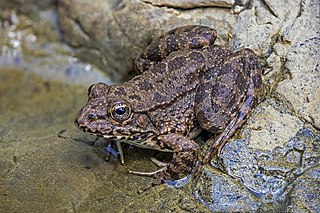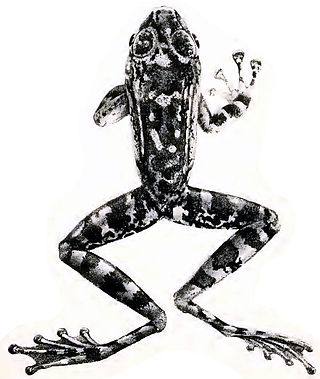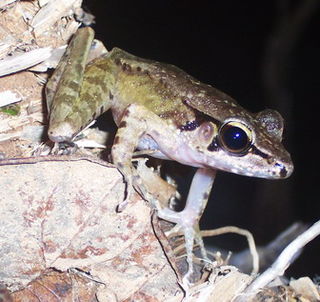
True frogs is the common name for the frog family Ranidae. They have the widest distribution of any frog family. They are abundant throughout most of the world, occurring on all continents except Antarctica. The true frogs are present in North America, northern South America, Europe, Africa, and Asia. The Asian range extends across the East Indies to New Guinea and a single species, the Australian wood frog, has spread into the far north of Australia.

Amolops is a genus of true frogs native mainly to eastern and south-eastern Asia. These frogs are closely related to such genera as Huia, Meristogenys, Odorrana, Pelophylax and Rana, but still form a distinct lineage among the core radiation of true frogs. They are commonly known as "torrent frogs" after their favorite habitat - small rapid-flowing mountain and hill streams - but this name is used for many similar-looking frogs regardless of whether they are loosely related.

Staurois is a small genus of minuscule true frogs. Most species in the genus are restricted to Borneo, but two species are from the Philippines. This genus is a quite ancient member of the true frog family, Ranidae. They are typically found in or near rapidly flowing, small rocky streams, and are sometimes known as splash frogs or foot-flagging frogs. The latter name refers to their unusual behavior of conspicuously waving their hindlegs and feet, as a way of signalling other members of the species. Similar behavior has also been documented in other frog genera, notably Hylodes and Micrixalus.

Hose's frog is a true frog species with a wide range in Southeast Asia. This species was named after zoologist Charles Hose.

Leptobrachium montanum is a species of frog from the family Megophryidae. It is endemic to Borneo and is, as currently defined, found in Kalimantan (Indonesia), Sabah and Sarawak (Malaysia), and Labi, Belait (Brunei). However, the nominal Leptobrachium montanum is a composed of more than one lineage. Available information mostly refers to this composite rather than the "true" Leptobrachium montanum. Common names montane large-eyed litter frog, mountain spadefoot toad, and mountain litter frog have been coined for it.

Amolops larutensis is a species of frog in the family Ranidae that is found in the Malay Peninsula from southernmost Thailand to Malaysia; records further north probably represent A. panhai.

The hole-in-the-head frog is a species of frog in the family Ranidae. It is the only member of the genus Huia. It is found on the island of Borneo. Its natural habitats are subtropical or tropical moist lowland forests, subtropical or tropical moist montane forests, and torrential rivers. It is threatened by habitat loss. The genus name honors Chinese herpetologist Shuchin Hu.
Meristogenys amoropalamus is a species of frog in the family Ranidae. It is endemic to northern Borneo and occurs in northwestern Sabah and northeastern Sarawak (Malaysia) and in northeastern Kalimantan (Indonesia). Common names mountain Borneo frog and mountain torrent frog have been coined for it. Studies of its larvae revealed that the nominal species contained two cryptic forms, and in 2011, Shimada and colleagues described Meristogenys dyscritus as a separate species.

Meristogenys jerboa is a species of frog in the family Ranidae. It is endemic to western Sarawak in Borneo. Common names western torrent frog, Matang torrent frog, and Gunther's Borneo frog have been coined for it. Many cryptic species have been separated from this species. Based on mitochondrial DNA, current "true" Meristogenys jerboa still includes two major lineages. However, because the lineages occur in sympatry and do not differ in morphology, Shimada and colleagues elected to treat them as intraspecific variants.
Meristogenys kinabaluensis is a species of frog in the family Ranidae. It is endemic to Borneo and is found in Sabah, Sarawak (Malaysia), and Kalimantan (Indonesia). The specific name refers to its type locality, Mount Kinabalu.
Meristogenys macrophthalmus is a species of frog in the family Ranidae. It is endemic to Sarawak in northern Borneo (Malaysia) and is only known from its type locality in the Bintulu District. The specific name macrophthalmus is derived from the Greek words macros (="large") and ophthalmos (="eye") and refers to the large eyes of this frog. Common names Matsui's Borneo frog, large-eyed torrent frog, and big-eyed torrent frog have been coined for it.
Meristogenys phaeomerus is a species of frog in the family Ranidae. It is endemic to Borneo and known from central Sarawak (Malaysia) and adjacent Kalimantan (Indonesia). The specific name phaeomerus is derived from the Greek phaios for "dusky" and meros for "thigh", in reference to the appearance of the rear of the thigh. Common names Kapit Borneo frog and Kapit torrent frog have been coined for it.
Meristogenys poecilus is a species of frog in the family Ranidae. It is endemic to Borneo and known from between central Sarawak (Malaysia) and central Kalimantan (Indonesia). The specific name poecilus is derived from the Greek poikolos, meaning "pied" or "blotched", in reference to diagnostic pattern on rear of the thigh. Common name Malaysian Borneo frog has been coined for this species.
Meristogenys whiteheadi is a species of frog in the family Ranidae. It is endemic to Borneo and found in both Indonesia (Kalimantan) and Malaysia. Meristogenys stigmachilus and Meristogenys stenocephalus, described as new species in 2011, were formerly included in this species. Owing to the difficulty of distinguishing these species under field conditions, the exact range of this species is uncertain. Its common name is Whitehead's Borneo frog or Whitehead's torrent frog.

Odorrana, commonly known as odorous frogs, is a genus of true frogs (Ranidae) from East Asia and surrounding regions. Many of these frogs inhabit fast-flowing mountain streams, and they typically have a remarkably pointed snout, as evidenced by common names like tip-nosed frog and scientific names like nasica or nasutus.
Sabahphrynus is a monotypic genus of amphibians in the family Bufonidae. The sole species is Sabahphrynus maculatus, also known as the spotted Asian tree toad or Sabah earless toad. It is endemic to Borneo where it is only known from Sabah, East Malaysia.

Feihyla inexpectata is a species of frog in the family Rhacophoridae. This recently (2014) described species is endemic to Malaysian Borneo and known from its type locality in the Maliau Basin Conservation Area, Sandakan Division, Sabah and from Danum Valley, also in Sabah. Common name Bornean opposite-fingered tree frog has been coined for it.

Rhacophorus borneensis is a species of frog in the family Rhacophoridae. This recently (2013) described species is endemic to Malaysian Borneo where it is known from its type locality in the Maliau Basin Conservation Area, Sandakan Division, Sabah as well as from the Batang Ai National Park, Sarawak. Prior to its description, it was included in Rhacophorus reinwardtii. It is said to be "one of the prettiest frogs of Borneo". Common name Borneo flying frog has been coined for it.
Meristogenys maryatiae, also known as Maryati's torrent frog, is a species of frog in the family Ranidae. It is endemic to the state of Sabah, in the Malaysian part of Borneo. The specific name honours Prof. Datin Mohamed Maryati, entomologist from the Universiti Malaysia Sabah, who helped the describers of this species during their herpetological surveys in Sabah.

Wijayarana is a group of true frogs found in Southeast Asia. Their common name is Wijaya cascade frogs. Many are commonly known as "torrent frogs" after their favorite habitat - small rapid-flowing mountain and hill streams -, but this name is used for many similar-looking frogs regardless of whether they are closely related.











